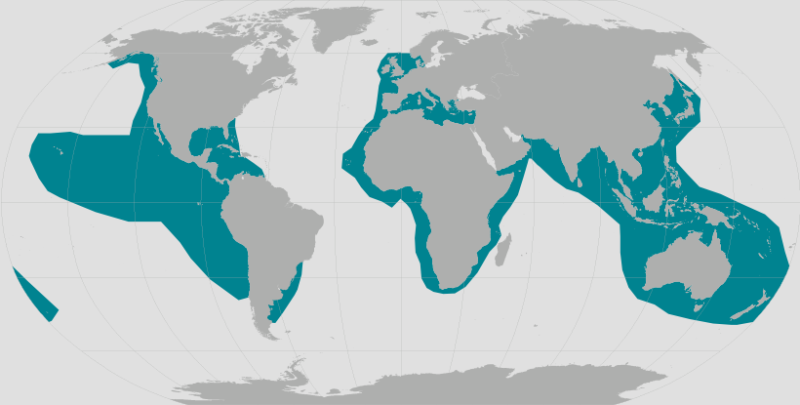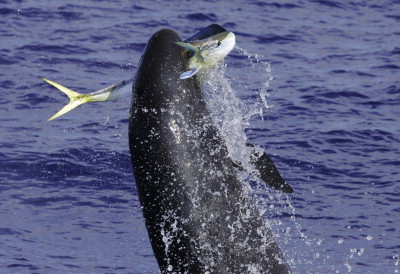False Killer Whales

An illustration of a false killer whale (NOAA Fisheries, 2022)
This semester, the Dolphin Acoustics Vertically Integrated Project (VIP) introduced a new study species, the distinctive false killer whale, or Pseudorca crassidens. Until now, our main study species was the rough-toothed dolphin, or Steno bredanensis, and more information about this species and our research can be found here. False killer whales have some similarities to rough-toothed dolphins, with both species tending to be found in deep waters in warm regions. Non-aggressive interactions between the two species have also been observed in the wild. Despite their name, false killer whales do not bear much external resemblance to killer whales (Orcinus orca)—the common name actually comes from their similar skulls. Although not as big as their namesake, false killer whales are large dolphins, and can be as long as six metres. They take a wide variety of prey, including squid, fish, and even other cetaceans. Food sharing has been observed in false killer whales. They are extremely social, forming long-term associations and living in large groups. These strong social bonds have sadly been linked to mass-strandings. This ecological overview comes from an encyclopaedia entry by Baird (2009).

A map showing the estimated range of false killer whales (NOAA Fisheries, 2022)
According to Baird (2009) and NOAA Fisheries (2022), the main threat to false killer whale populations is fishing. They are attracted to bait in longline fisheries, which can lead to entanglement, injuries, and drowning. Many of the fish species targeted by fisheries are important in the diet of false killer whales, leading to direct competition. False killer whales are sometimes shot by fishermen because of this. Fishery-related deaths occur at a higher rate than false killer whales are able to naturally recover from, and they are not the only pressure on this species. False killer whales are also vulnerable to pollution. Pollutants become concentrated through the food chain, meaning top predators like false killer whales are exposed to particularly high levels of contaminants. Population monitoring of this species is essential to inform conservation efforts, and it is vital that we reduce these human pressures false killer whales. This is especially important for the population we are studying, which resides in the waters around Hawaii, as this is a small population so may have reduced genetic diversity and increased vulnerability to stressors.

A false killer whale hunting a mahi-mahi (Coryphaena hippurus), a fish species targeted by Hawaiian fisheries (photo by Daniel J. McSweeney, from Baird, 2009)
Acoustic methods are very useful for studying cetaceans like false killer whales, as they are highly vocal, using sounds for communication and finding prey. More information on acoustic research with cetaceans can be found in a chapter by one of the staff members on this project, Janik (2009). A study by Gruden et al. (2022), has shown that acoustic monitoring can be used to identify different groups of false killer whales, as different groups have different acoustic behaviours. Some groups only echolocate, some only whistle, and some groups do both. This type of monitoring is known as passive acoustic monitoring (PAM), and uses recordings from hydrophones to assess the species present in an area. Sophisticated PAM techniques can be used from species identification and abundance estimations.
This VIP aims to contribute to the improvement of PAM techniques for false killer whales. The team are using two programs to extract and trace whistles from recordings of false killer whales taken on ship surveys off the coast of Hawaii. The first program, Raven, is used to identify individual whistles from spectrograms—visual representations of sound recordings. A second program, PAMGuard, is used to trace these whistles and extract parameters such as whistle length and frequencies. Once enough whistles have been traced to give a large dataset, they can be analysed in Artwarp, a program which uses the whistle parameters from PAMGuard to categorise whistles into types. This will give a better understanding of the false killer whales’ whistle repertoire—the range of whistles they can produce. The whistle dataset can also be used to train machine learning software, which can identify species based on PAM recordings. More information can be found on our ‘What We Do’ page. All of this research will be useful for population monitoring and conservation of this charismatic species.

The interface of Raven, one of the programs used in this VIP, showing a false killer whale whistle identified on a spectrogram.
References
Baird, R.W. (2009) ‘F – False Killer Whale: Pseudorca crassidens’, in W.F. Perrin, B. Würsig, and J.G.M. Thewissen (eds) Encyclopedia of Marine Mammals (Second Edition). London: Academic Press, pp. 405–406. Available at: https://doi.org/10.1016/B978-0-12-373553-9.00097-3.
Gruden, P., Barkley, Y. and McCullough, J.L. (2022) ‘Insights into acoustic behavior of false killer whales’, The Journal of the Acoustical Society of America, 151(4), pp. A74–A75. Available at: https://doi.org/10.1121/10.0010703.
Janik, V.M. (2009) ‘Chapter 4 Acoustic Communication in Delphinids’, in Advances in the Study of Behavior. Academic Press, pp. 123–157. Available at: https://doi.org/10.1016/S0065-3454(09)40004-4.
NOAA (2022) False Killer Whale | NOAA Fisheries, NOAA. Available at: https://www.fisheries.noaa.gov/species/false-killer-whale (Accessed: 1 April 2023).